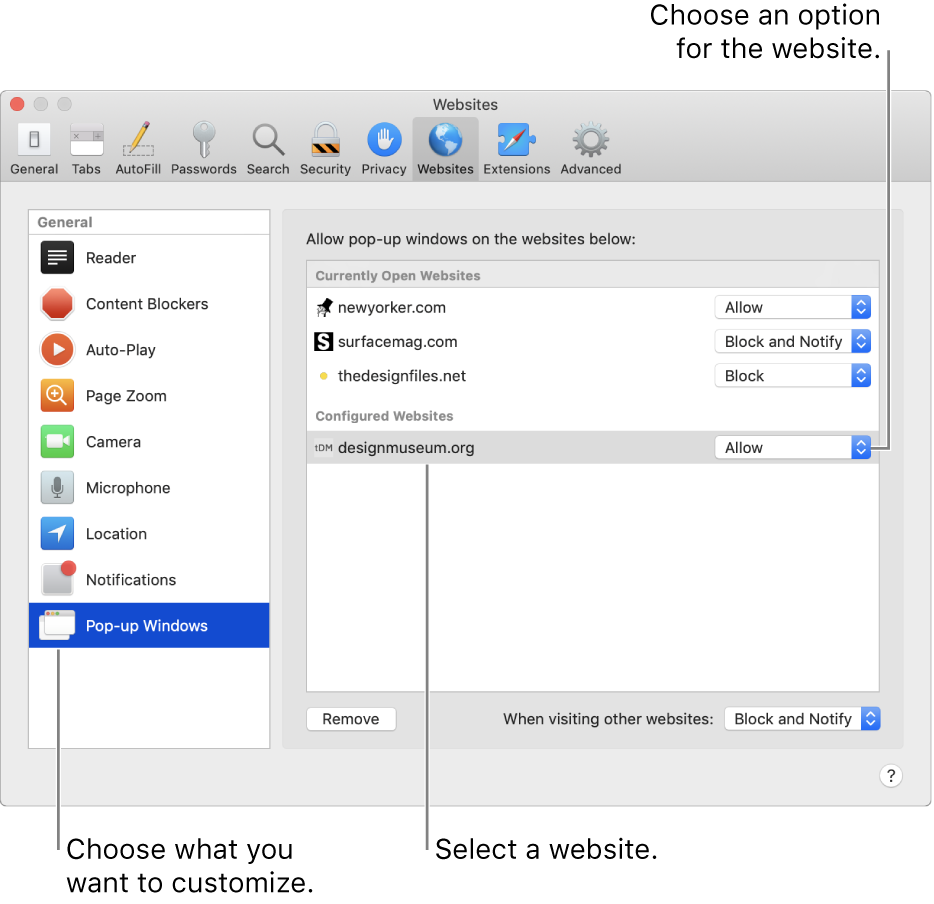
(There’s bound to be a page magnification value that will render a website at just the right size for you.) Notifications center already allowed you to enable or disable notifications delivered via Safari, but the addition of Notifications to Safari’s Websites preferences rounds up all those websites that want to send you notifications into one convenient place for easier management.
#CONFIGURE SAFARI PREFERENCES FOR ALL USERS ON MAC MAC#
Now with Safari 11 and later, Apple has expanded the granularity so that you can specify which websites are allowed to use location services, as opposed to previous Mac versions, where the only options for the Safari app were to turn location services on or off. Location services have been part of the Mac for a while. Microphone performs a similar task to Camera, allowing you to control which websites can make use of your Mac’s microphone. Settings are on a website-by-website basis. You can allow a website to access your Mac’s camera always, never, or have the site ask each time. Page Zoom can be set for zoom rates from 50% to 300% on a site-by-site basis.Ĭamera allows you to specify whether a website can make use of your Mac’s camera. Page Zoom lets you set a zoom level for websites that are fond of using small type or thumbnails, or even for sites that have huge images that force you to zoom out to see the whole image. (Auto-Play allows you to disable embedded audio and video content from starting on its own.) Like all of Safari’s website management settings, you can control auto-play on a site-by-site basis, allowing all auto play, preventing audio, preventing video, or preventing both. You can allow content to start playing on its own, as the website intended, or you can take control and put a stop to the automatic running of audio and video, which can be a bit annoying, especially when you have multiple websites open. Auto-Play puts you in control of how audio and video content on a website are delivered to you. The newest version of the content blocker goes much further, providing a reasonable ad blocking mechanism as well as the ability to manage the settings on a website-by-website basis.Īuto-Play helps you control websites that love to start playing embedded audio and video content as soon as you land on the page. Reader will usually strip out embedded video, most ads, and sponsored links, leaving just the main section of the webpage.Įarlier versions of Safari required you to manually select Reader mode whenever you visited a website, but with Safari 11 and later, you can assign websites to automatically open in Reader mode.Ĭontent Blockers have been part of Safari for a while they were originally designed to prevent those annoying popup or pop-under windows. Reader is a way for Safari to strip out unnecessary elements of the webpage and just display the main content. With Safari 11, there are eight specific items you can control for each website you visit: Safari supports a number of customization controls for each website you visit, giving you a great deal of flexibility in how a website behaves. (The Websites preference allows you to customize how a website is displayed and what services it’s allowed to use.) When you browse the web, you should never encounter a website that auto-plays sound or video, until you land on the sites where you’ve specifically allowed auto-play to work. When the two are in conflict, the settings for a specific website override those set for all websites.Ī simple example is that you may set all websites to never auto-play audio or video content, but then configure your favorite video service to allow auto-play. Website customization works on two main levels you can define how all websites will be handled, and you can specify how individual websites will be managed. (With Safari 11 and later, you can apply many settings on a website-by-website basis.) It’s a powerful tool that can help you tame the wild web.

But in this Rocket Yard Guide, we’re going to look at Safari’s new ability to customize how a website looks and performs on a site-by-site basis.

Safari 11, the version included with macOS High Sierra, has a number of new features, including advanced methods of preventing user tracking (Intelligent Tracking Prevention).


But Safari rolls out a whole new way to work with websites, putting you in control and allowing for quite a bit of customization in your viewing. You may have already read about Safari’s new ability to block user tracking by websites, or its new ability to prevent video from auto-playing. The version of Safari included with macOS High Sierra brings new and significant abilities to customize how it works with each website you visit.


 0 kommentar(er)
0 kommentar(er)
